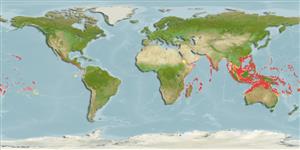Environment: milieu / climate zone / depth range / distribution range
Ökologie
seewasser; süßwasser; brackwasser demersal; katadrom (Ref. 51243); tiefenbereich 1 - 400 m (Ref. 6898). Tropical; 31°N - 35°S, 21°E - 134°W
Indo-Pacific: East Africa, inland Mozambique and lower Zambezi River to French Polynesia, north to southern Japan (Ref. 7050). Also rivers of Madagascar and adjacent islands (Ref. 52193).
Size / Gewicht / Alter
Maturity: Lm ? range ? - ? cm
Max length : 70.0 cm TL Männchen/unbestimmt; (Ref. 57749); 200.0 cm TL (female); common length : 26.3 cm TL Männchen/unbestimmt; (Ref. 35840); max. veröff. Gewicht: 20.5 kg (Ref. 13337); max. veröff. Gewicht: 20.5 kg; max. veröff. Alter: 40 Jahre (Ref. 48660)
Wirbelzahl: 100 - 110. Diagnosis: Distinguished from all other species by the mottled colour and the long dorsal fin, which begins closer to the gill opening than to the anus (Ref. 9828).
Live in freshwater areas as adults, estuaries and seas as young (Ref. 12693). Found in lowland rivers as well as upland tributaries (Ref. 2847). While in river, the sex gland does not develop. But in winter when they move from the stream to river mouth, the sex gland begins to develop as mature individuals go to deep sea to breed (Ref. 45563). The spawning grounds are deep sea gullies among the south of the Philippines, east of Indonesia and Papua New Guinea (Ref. 45563). Are active at night, feeding on a wide range of prey (Ref. 7248, 79840), especially crabs, frogs and fish (Ref. 7248). Thought to breed east of Madagascar where the young are wafted to the East Coast by ocean currents (Ref. 13337, 79840).
Life cycle and mating behavior
Geschlechtsreife | Fortpflanzung | Ablaichen | Eier | Fecundity | Larven
Castle, P.H.J., 1984. Anguillidae. p. 34-37. In J. Daget, J.-P. Gosse and D.F.E. Thys van den Audenaerde (eds.) Check-list of the freshwater fishes of Africa (CLOFFA). ORSTOM, Paris and MRAC, Tervuren. Vol. 1. (Ref. 3506)
IUCN Rote Liste Status (Ref. 130435)
Bedrohung für Menschen
Harmless
Nutzung durch Menschen
Fischereien: kommerziell; Aquakultur: kommerziell; Sportfisch: ja
Mehr Information
NamenSynonymeMetabolismusRäuberÖkotoxikologieFortpflanzungGeschlechtsreifeAblaichenSpawning aggregationFecundityEierEientwicklung
ReferenzenAquakulturAquakultur ProfilZuchtlinienGenetikElectrophoresesVererbbarkeitKrankheitenVerarbeitungNutrientsMass conversion
Tools
Zusatzinformationen
Download XML
Internet Quellen
Estimates based on models
Preferred temperature (Ref.
123201): 15.7 - 27.8, mean 24.5 °C (based on 725 cells).
Phylogenetic diversity index (Ref.
82804): PD
50 = 0.5000 [Uniqueness, from 0.5 = low to 2.0 = high].
Bayesian length-weight: a=0.00076 (0.00037 - 0.00155), b=3.17 (3.00 - 3.34), in cm total length, based on LWR estimates for this Genus-body shape (Ref.
93245).
Trophic level (Ref.
69278): 3.8 ±0.67 se; based on food items.
Widerstandsfähigkeit (Ref.
120179): sehr niedrig, Verdopplung der Population dauert mehr als 14 Jahre. (tmax=40).
Fishing Vulnerability (Ref.
59153): Very high vulnerability (90 of 100).
